NISSAN LEAF 2023 Manual Online
Manufacturer: NISSAN, Model Year: 2023, Model line: LEAF, Model: NISSAN LEAF 2023Pages: 612, PDF Size: 7.42 MB
Page 81 of 612
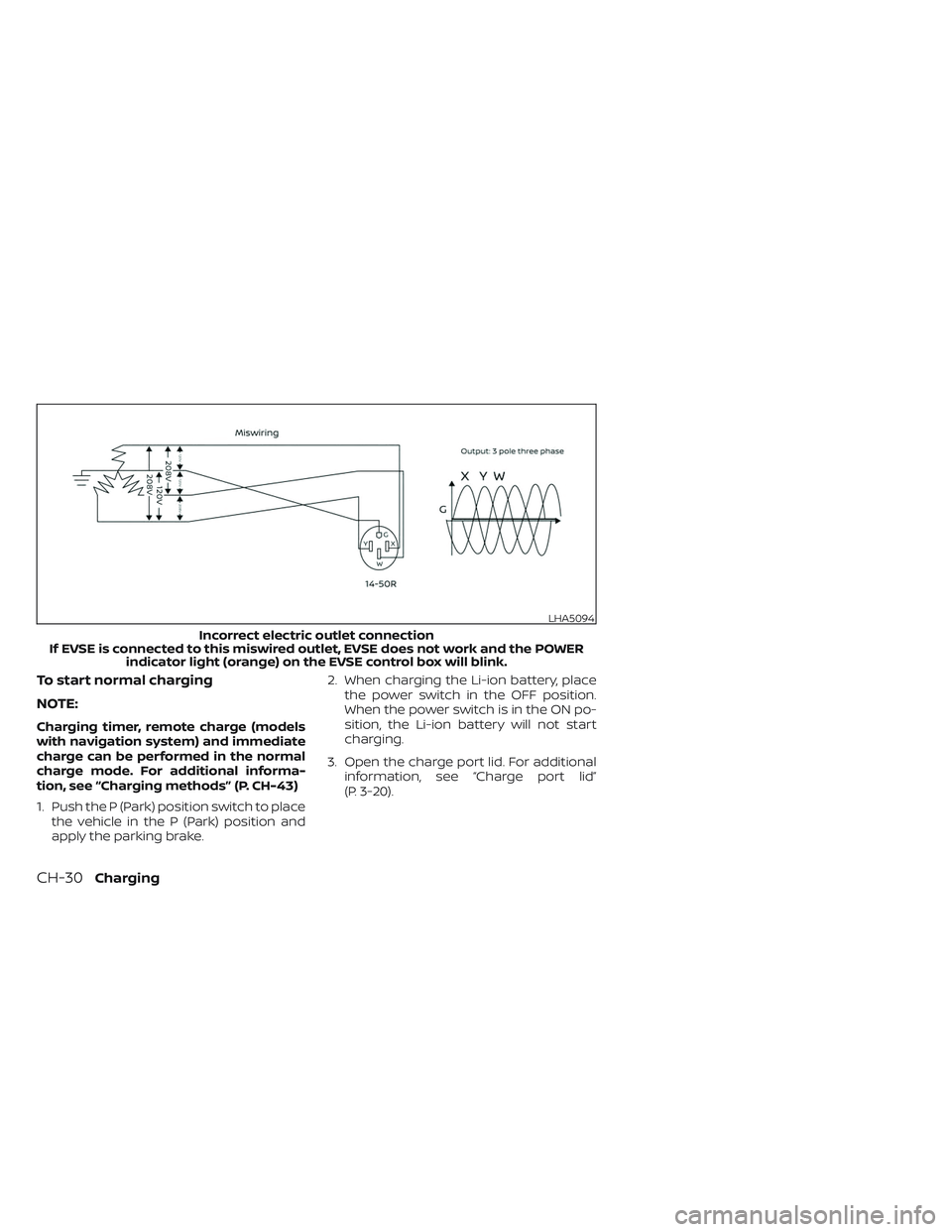
To start normal charging
NOTE:
Charging timer, remote charge (models
with navigation system) and immediate
charge can be performed in the normal
charge mode. For additional informa-
tion, see “Charging methods” (P. CH-43)
1. Push the P (Park) position switch to placethe vehicle in the P (Park) position and
apply the parking brake. 2. When charging the Li-ion battery, place
the power switch in the OFF position.
When the power switch is in the ON po-
sition, the Li-ion battery will not start
charging.
3. Open the charge port lid. For additional information, see “Charge port lid”
(P. 3-20).
LHA5094
Incorrect electric outlet connection
If EVSE is connected to this miswired outlet, EVSE does not work and the POWER indicator light (orange) on the EVSE control box will blink.
CH-30Charging
Page 82 of 612
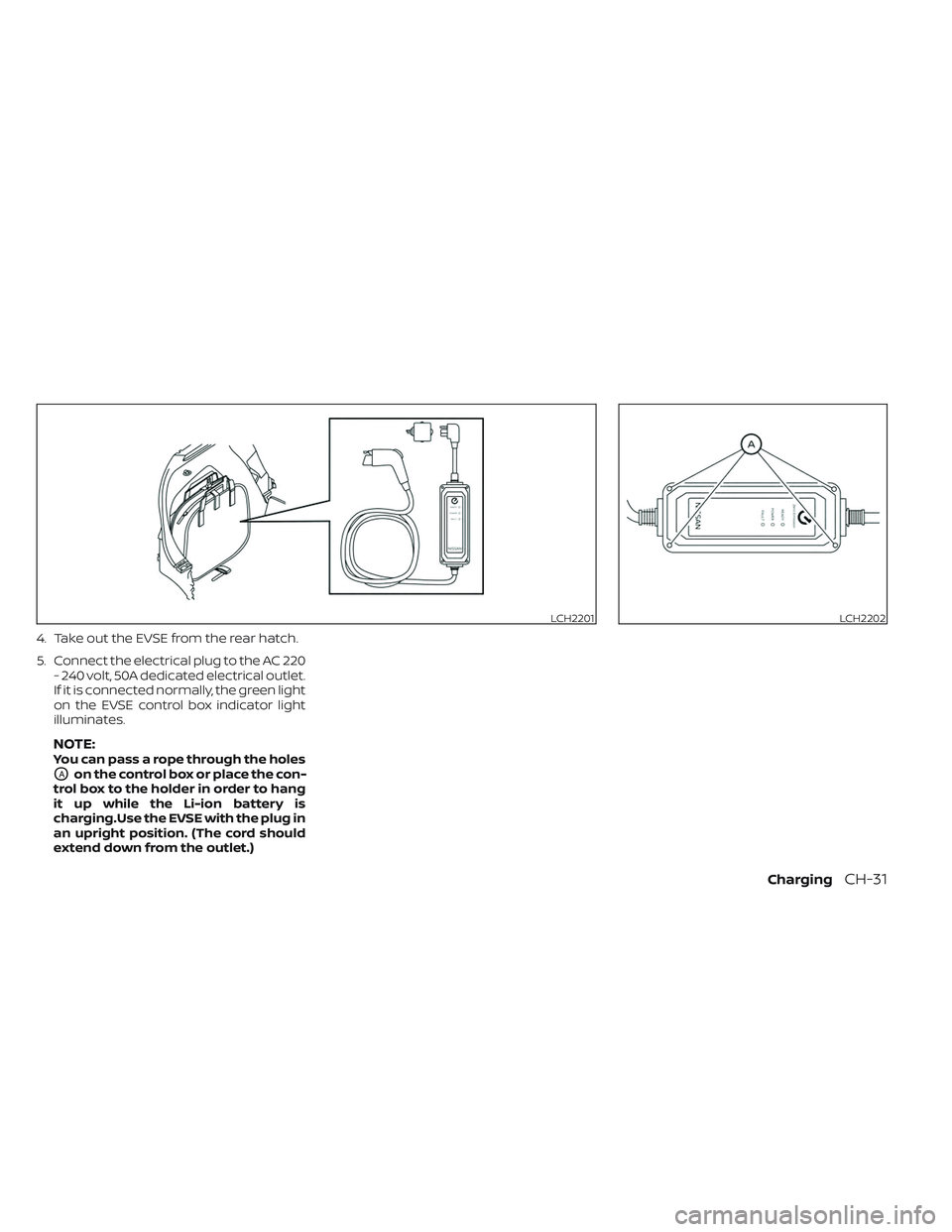
4. Take out the EVSE from the rear hatch.
5. Connect the electrical plug to the AC 220- 240 volt, 50A dedicated electrical outlet.
If it is connected normally, the green light
on the EVSE control box indicator light
illuminates.
NOTE:You can pass a rope through the holes
OAon the control box or place the con-
trol box to the holder in order to hang
it up while the Li-ion battery is
charging.Use the EVSE with the plug in
an upright position. (The cord should
extend down from the outlet.)
LCH2201LCH2202
ChargingCH-31
Page 83 of 612
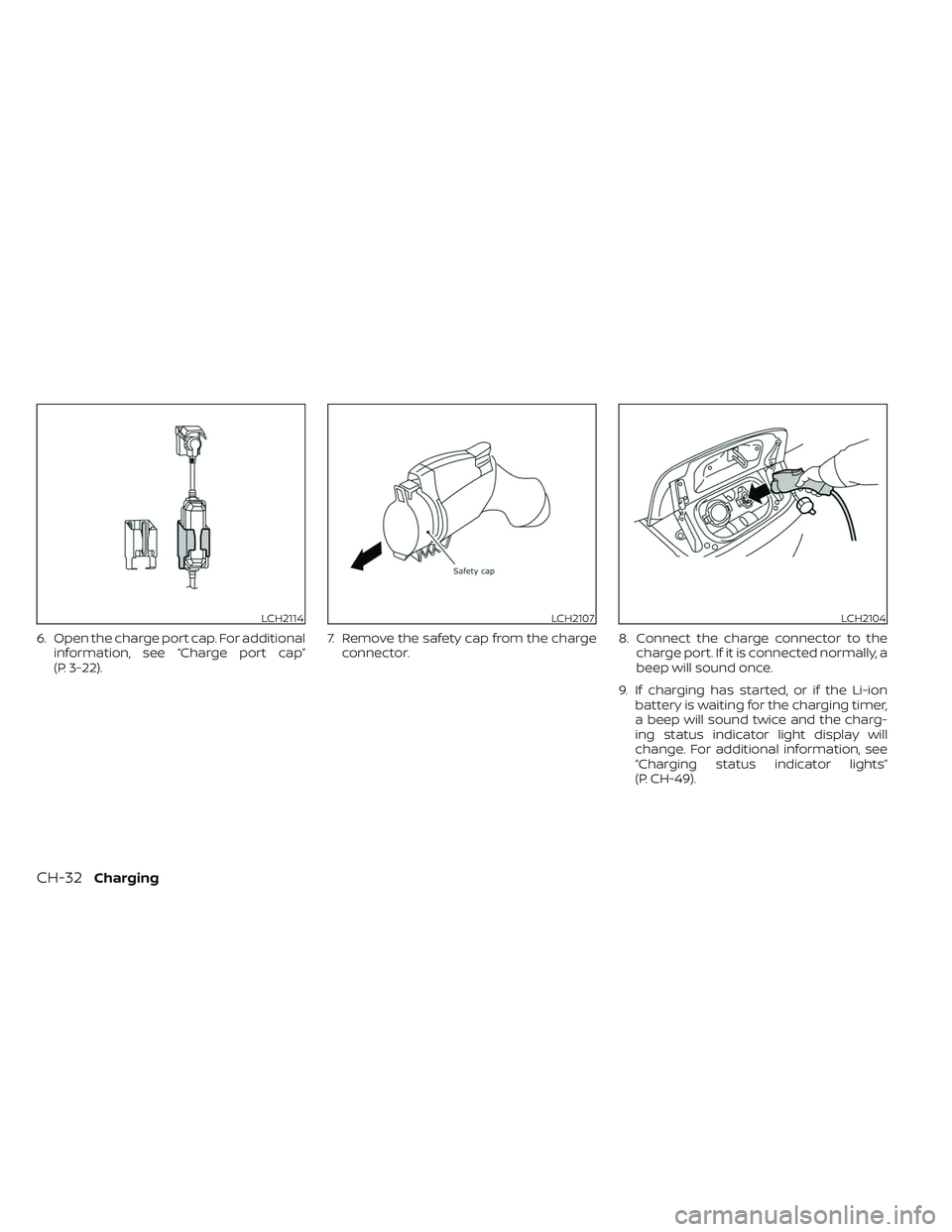
6. Open the charge port cap. For additionalinformation, see “Charge port cap”
(P. 3-22). 7. Remove the safety cap from the charge
connector. 8. Connect the charge connector to the
charge port. If it is connected normally, a
beep will sound once.
9. If charging has started, or if the Li-ion battery is waiting for the charging timer,
a beep will sound twice and the charg-
ing status indicator light display will
change. For additional information, see
“Charging status indicator lights”
(P. CH-49).
LCH2114LCH2107LCH2104
CH-32Charging
Page 84 of 612
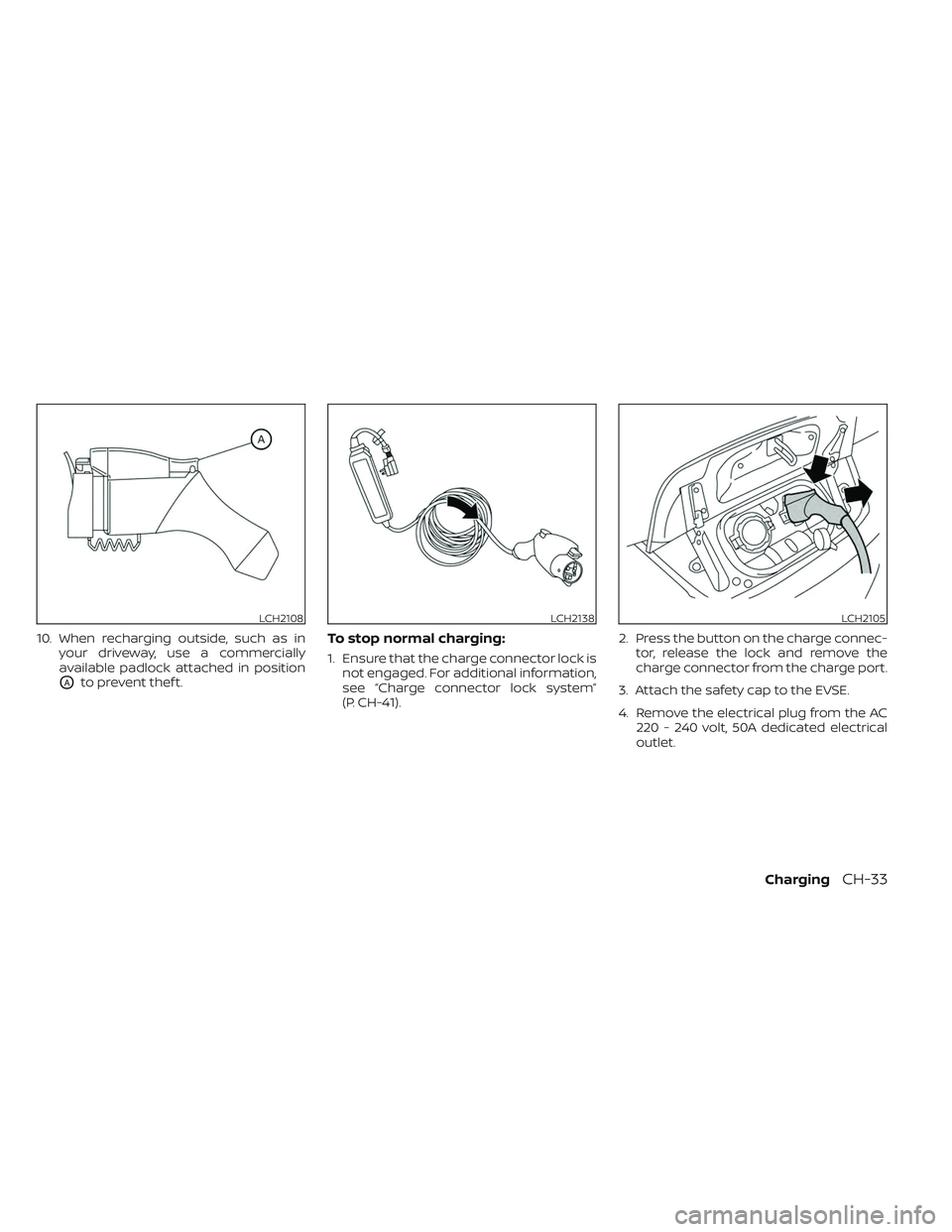
10. When recharging outside, such as inyour driveway, use a commercially
available padlock attached in position
OAto prevent thef t.
To stop normal charging:
1. Ensure that the charge connector lock isnot engaged. For additional information,
see “Charge connector lock system”
(P. CH-41). 2. Press the button on the charge connec-
tor, release the lock and remove the
charge connector from the charge port.
3. Attach the safety cap to the EVSE.
4. Remove the electrical plug from the AC 220 - 240 volt, 50A dedicated electrical
outlet.
LCH2108LCH2138LCH2105
ChargingCH-33
Page 85 of 612
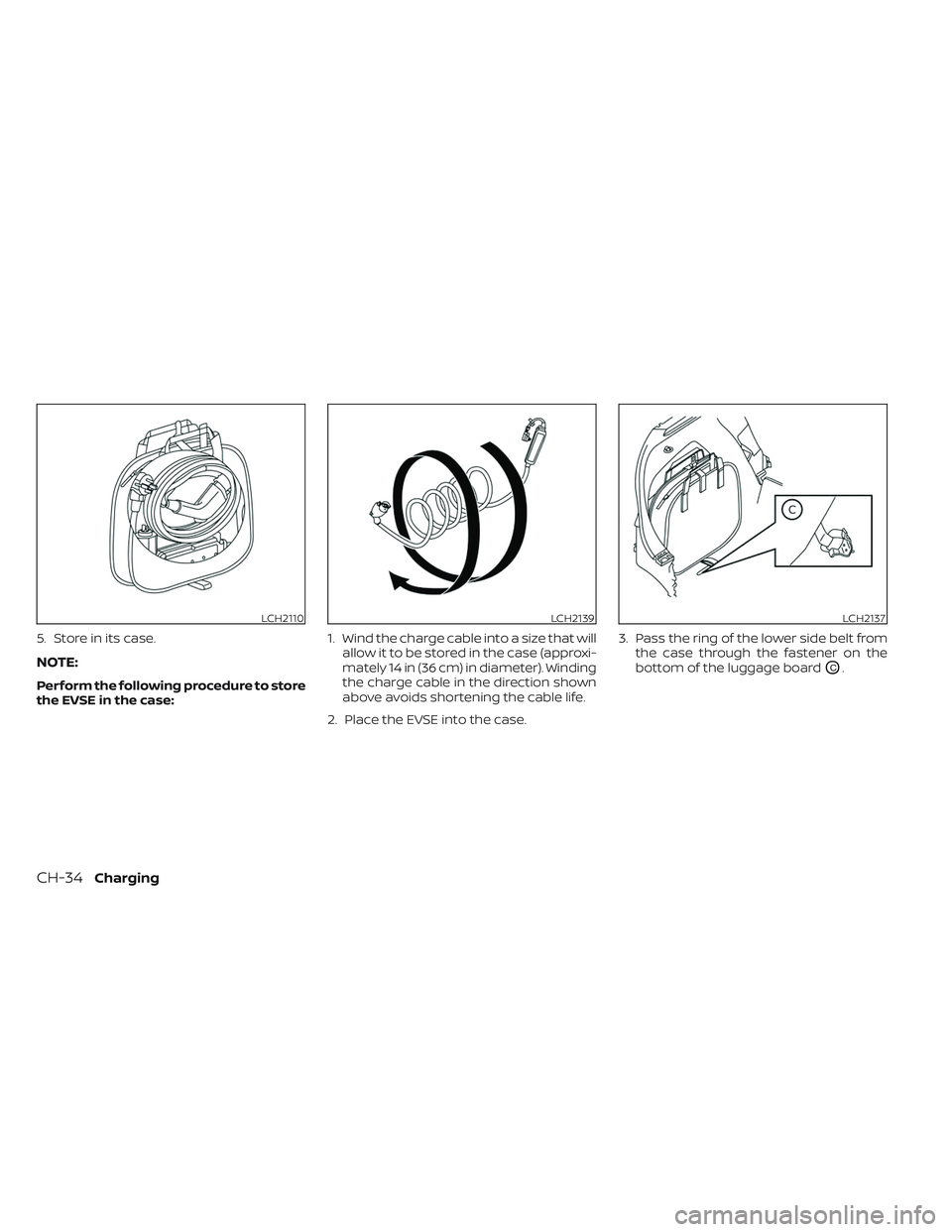
5. Store in its case.
NOTE:
Perform the following procedure to store
the EVSE in the case:1. Wind the charge cable into a size that will
allow it to be stored in the case (approxi-
mately 14 in (36 cm) in diameter). Winding
the charge cable in the direction shown
above avoids shortening the cable life.
2. Place the EVSE into the case. 3. Pass the ring of the lower side belt from
the case through the fastener on the
bottom of the luggage board
OC.
LCH2110LCH2139LCH2137
CH-34Charging
Page 86 of 612
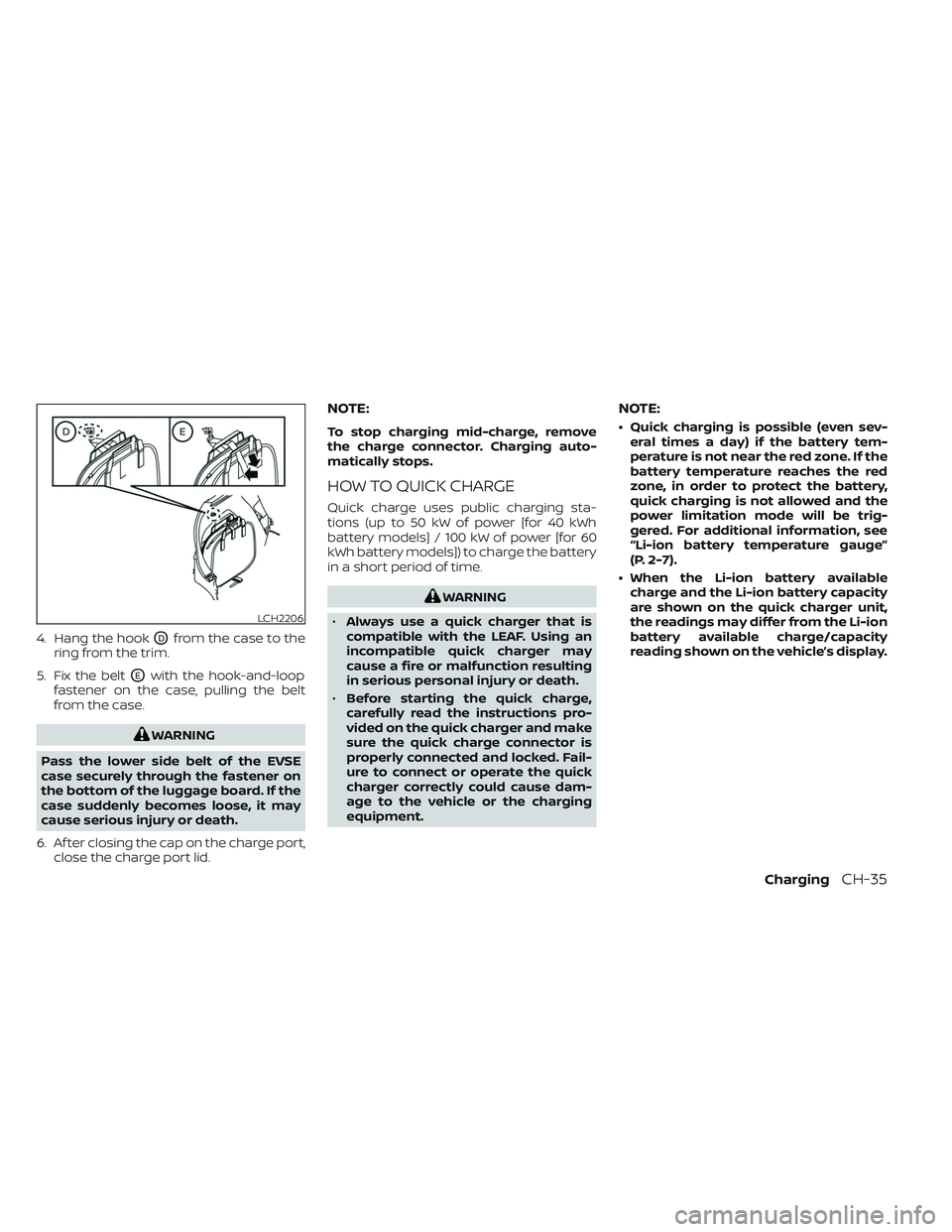
4. Hang the hookODfrom the case to the
ring from the trim.
5. Fix the belt
OEwith the hook-and-loop
fastener on the case, pulling the belt
from the case.
WARNING
Pass the lower side belt of the EVSE
case securely through the fastener on
the bottom of the luggage board. If the
case suddenly becomes loose, it may
cause serious injury or death.
6. Af ter closing the cap on the charge port, close the charge port lid.
NOTE:
To stop charging mid-charge, remove
the charge connector. Charging auto-
matically stops.
HOW TO QUICK CHARGE
Quick charge uses public charging sta-
tions (up to 50 kW of power [for 40 kWh
battery models] / 100 kW of power [for 60
kWh battery models]) to charge the battery
in a short period of time.
WARNING
• Always use a quick charger that is
compatible with the LEAF. Using an
incompatible quick charger may
cause a fire or malfunction resulting
in serious personal injury or death.
• Before starting the quick charge,
carefully read the instructions pro-
vided on the quick charger and make
sure the quick charge connector is
properly connected and locked. Fail-
ure to connect or operate the quick
charger correctly could cause dam-
age to the vehicle or the charging
equipment.
NOTE:
• Quick charging is possible (even sev- eral times a day) if the battery tem-
perature is not near the red zone. If the
battery temperature reaches the red
zone, in order to protect the battery,
quick charging is not allowed and the
power limitation mode will be trig-
gered. For additional information, see
“Li-ion battery temperature gauge”
(P. 2-7).
• When the Li-ion battery available charge and the Li-ion battery capacity
are shown on the quick charger unit,
the readings may differ from the Li-ion
battery available charge/capacity
reading shown on the vehicle’s display.
LCH2206
ChargingCH-35
Page 87 of 612
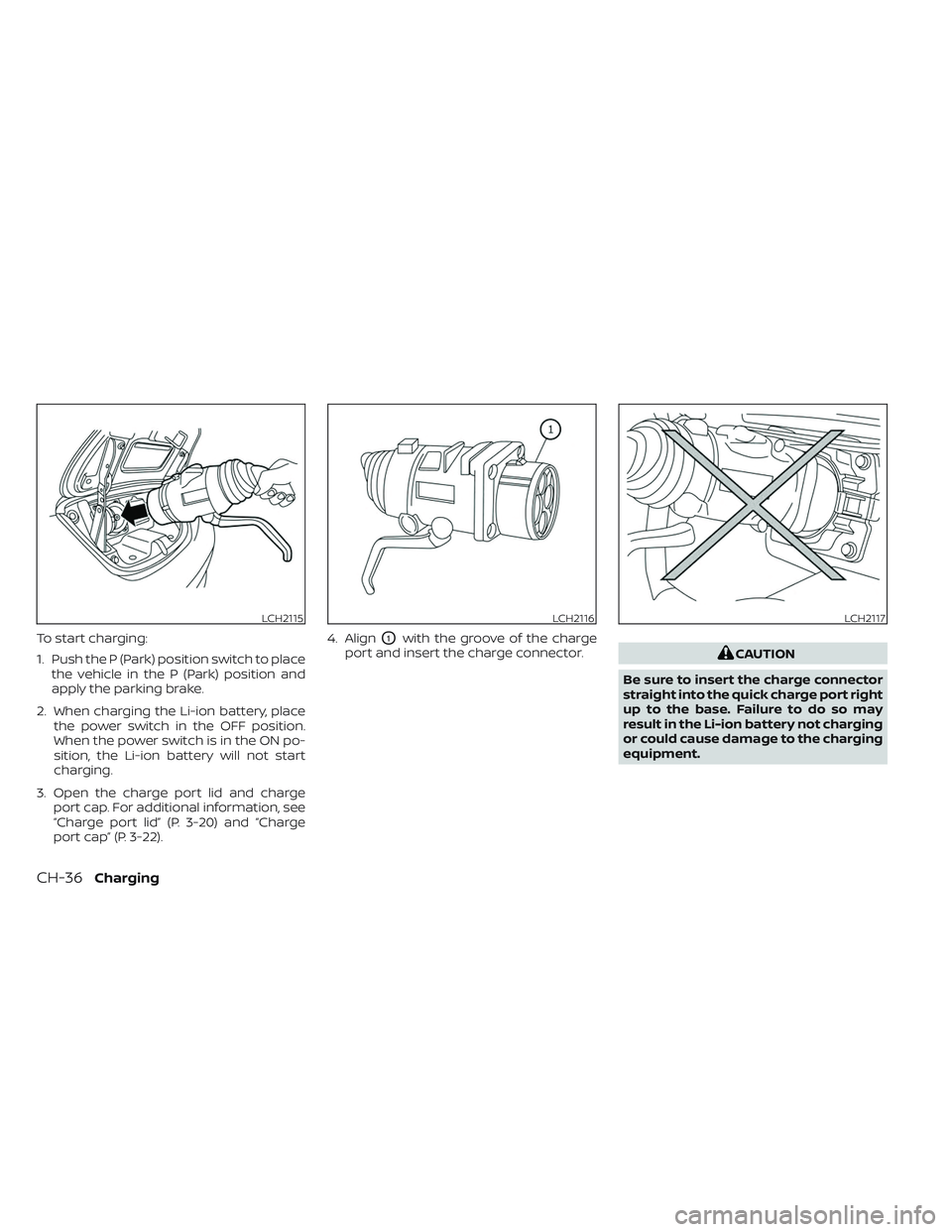
To start charging:
1. Push the P (Park) position switch to placethe vehicle in the P (Park) position and
apply the parking brake.
2. When charging the Li-ion battery, place the power switch in the OFF position.
When the power switch is in the ON po-
sition, the Li-ion battery will not start
charging.
3. Open the charge port lid and charge port cap. For additional information, see
“Charge port lid” (P. 3-20) and “Charge
port cap” (P. 3-22). 4. AlignO1with the groove of the charge
port and insert the charge connector.
CAUTION
Be sure to insert the charge connector
straight into the quick charge port right
up to the base. Failure to do so may
result in the Li-ion battery not charging
or could cause damage to the charging
equipment.
LCH2115LCH2116LCH2117
CH-36Charging
Page 88 of 612
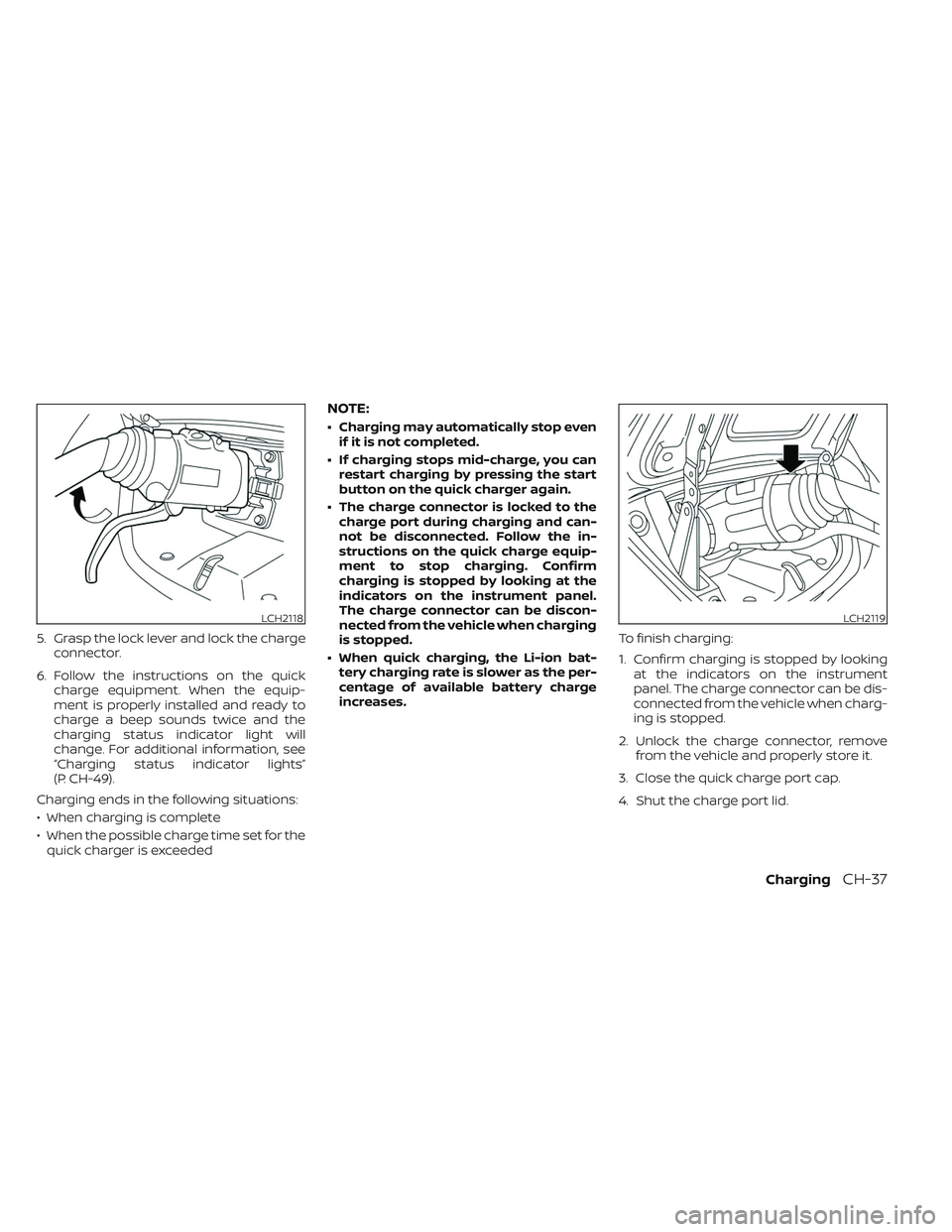
5. Grasp the lock lever and lock the chargeconnector.
6. Follow the instructions on the quick charge equipment. When the equip-
ment is properly installed and ready to
charge a beep sounds twice and the
charging status indicator light will
change. For additional information, see
“Charging status indicator lights”
(P. CH-49).
Charging ends in the following situations:
• When charging is complete
• When the possible charge time set for the quick charger is exceeded
NOTE:
• Charging may automatically stop even if it is not completed.
• If charging stops mid-charge, you can restart charging by pressing the start
button on the quick charger again.
• The charge connector is locked to the charge port during charging and can-
not be disconnected. Follow the in-
structions on the quick charge equip-
ment to stop charging. Confirm
charging is stopped by looking at the
indicators on the instrument panel.
The charge connector can be discon-
nected from the vehicle when charging
is stopped.
• When quick charging, the Li-ion bat- tery charging rate is slower as the per-
centage of available battery charge
increases. To finish charging:
1. Confirm charging is stopped by looking
at the indicators on the instrument
panel. The charge connector can be dis-
connected from the vehicle when charg-
ing is stopped.
2. Unlock the charge connector, remove from the vehicle and properly store it.
3. Close the quick charge port cap.
4. Shut the charge port lid.
LCH2118LCH2119
ChargingCH-37
Page 89 of 612
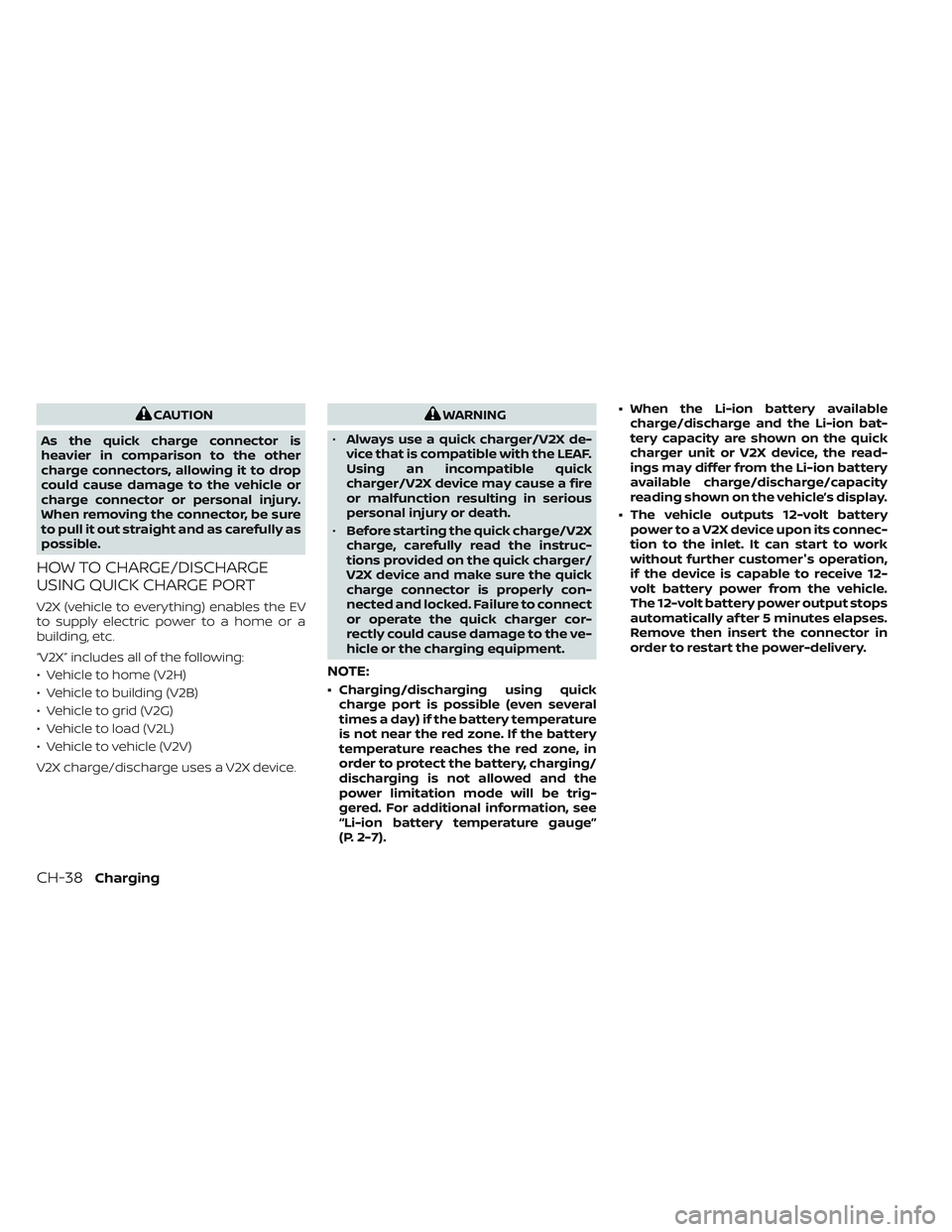
CAUTION
As the quick charge connector is
heavier in comparison to the other
charge connectors, allowing it to drop
could cause damage to the vehicle or
charge connector or personal injury.
When removing the connector, be sure
to pull it out straight and as carefully as
possible.
HOW TO CHARGE/DISCHARGE
USING QUICK CHARGE PORT
V2X (vehicle to everything) enables the EV
to supply electric power to a home or a
building, etc.
“V2X ” includes all of the following:
• Vehicle to home (V2H)
• Vehicle to building (V2B)
• Vehicle to grid (V2G)
• Vehicle to load (V2L)
• Vehicle to vehicle (V2V)
V2X charge/discharge uses a V2X device.
WARNING
• Always use a quick charger/V2X de-
vice that is compatible with the LEAF.
Using an incompatible quick
charger/V2X device may cause a fire
or malfunction resulting in serious
personal injury or death.
• Before starting the quick charge/V2X
charge, carefully read the instruc-
tions provided on the quick charger/
V2X device and make sure the quick
charge connector is properly con-
nected and locked. Failure to connect
or operate the quick charger cor-
rectly could cause damage to the ve-
hicle or the charging equipment.
NOTE:
• Charging/discharging using quick charge port is possible (even several
times a day) if the battery temperature
is not near the red zone. If the battery
temperature reaches the red zone, in
order to protect the battery, charging/
discharging is not allowed and the
power limitation mode will be trig-
gered. For additional information, see
“Li-ion battery temperature gauge”
(P. 2-7). • When the Li-ion battery available
charge/discharge and the Li-ion bat-
tery capacity are shown on the quick
charger unit or V2X device, the read-
ings may differ from the Li-ion battery
available charge/discharge/capacity
reading shown on the vehicle’s display.
• The vehicle outputs 12-volt battery power to a V2X device upon its connec-
tion to the inlet. It can start to work
without further customer's operation,
if the device is capable to receive 12-
volt battery power from the vehicle.
The 12-volt battery power output stops
automatically af ter 5 minutes elapses.
Remove then insert the connector in
order to restart the power-delivery.
CH-38Charging
Page 90 of 612
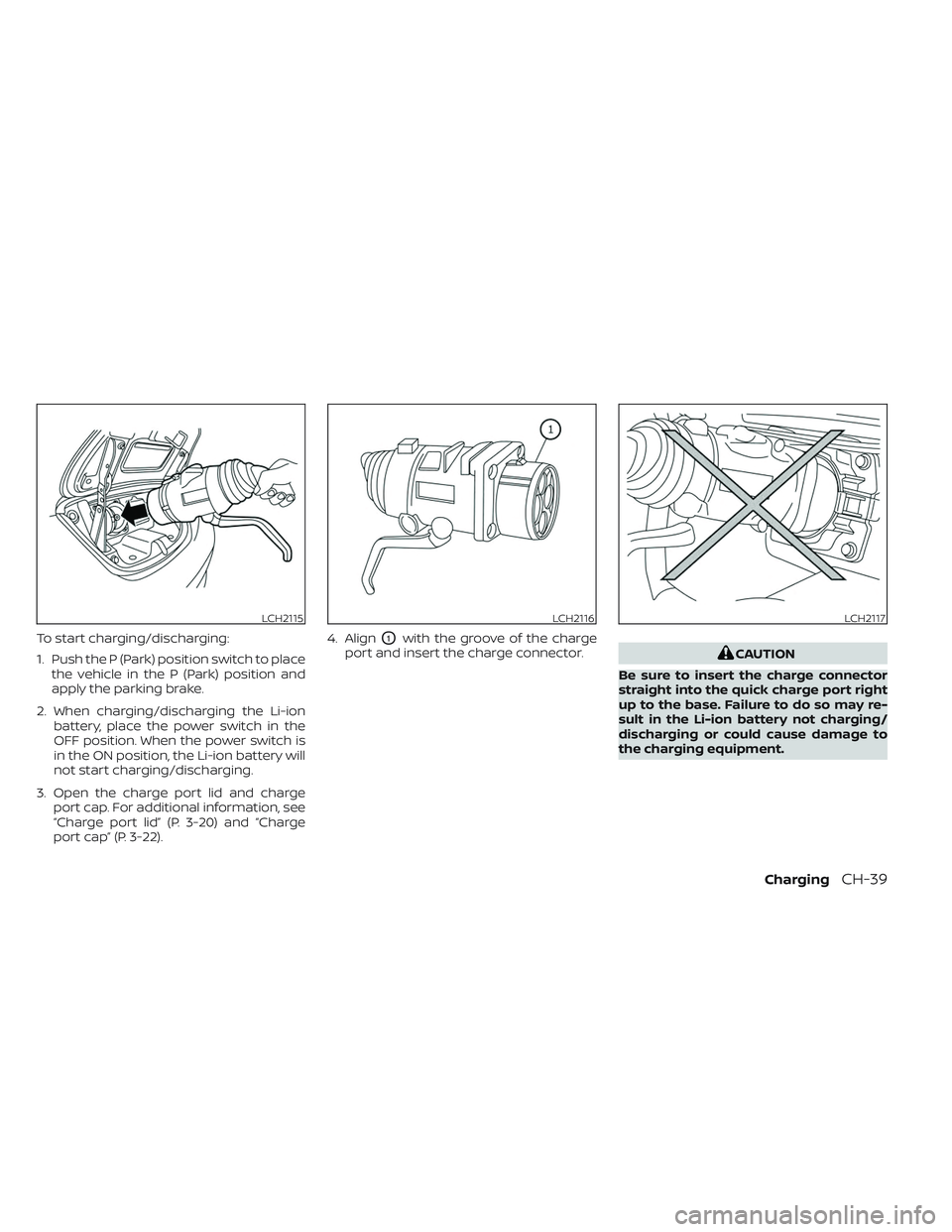
To start charging/discharging:
1. Push the P (Park) position switch to placethe vehicle in the P (Park) position and
apply the parking brake.
2. When charging/discharging the Li-ion battery, place the power switch in the
OFF position. When the power switch is
in the ON position, the Li-ion battery will
not start charging/discharging.
3. Open the charge port lid and charge port cap. For additional information, see
“Charge port lid” (P. 3-20) and “Charge
port cap” (P. 3-22). 4. AlignO1with the groove of the charge
port and insert the charge connector.
CAUTION
Be sure to insert the charge connector
straight into the quick charge port right
up to the base. Failure to do so may re-
sult in the Li-ion battery not charging/
discharging or could cause damage to
the charging equipment.
LCH2115LCH2116LCH2117
ChargingCH-39